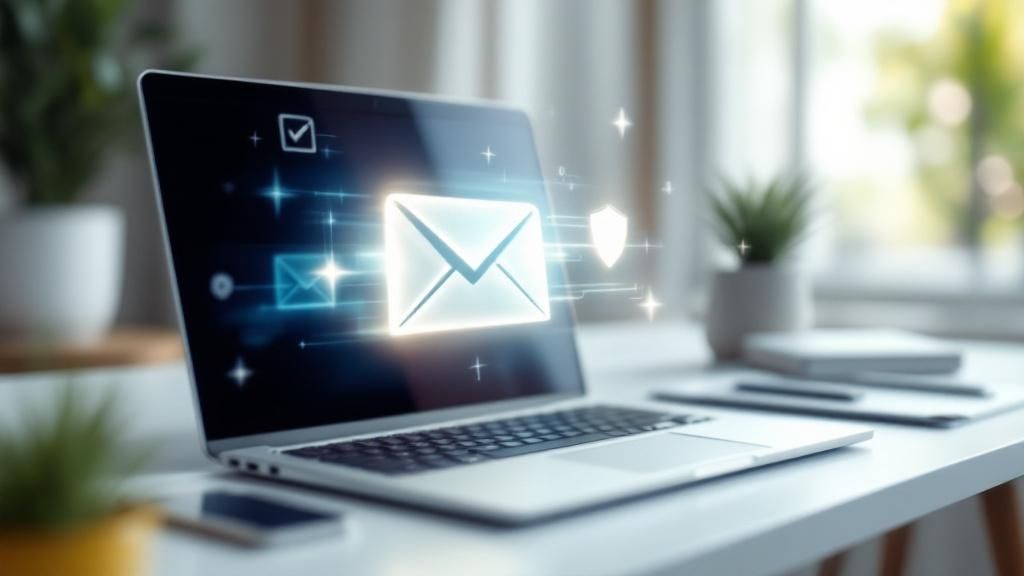In the world of B2B sales, the first email is just the beginning. The real art lies in the follow-up, yet most reps either give up too soon or send generic "just checking in" messages that land directly in the trash. The difference between a stalled deal and a signed contract often comes down to a persistent, strategic, and value-driven follow-up sequence. Silence from a prospect doesn't mean "no" – it often just means "not right now," or that your message failed to connect.
This guide moves beyond basic templates to provide a deep dive into six proven sales email follow up examples. We'll break down the psychology behind why each one works, provide actionable templates you can adapt, and outline the strategic thinking required to turn silence into a conversation. You will learn specific tactics for re-engaging cold prospects, building credibility with social proof, and gracefully closing out a non-responsive lead to make room for new opportunities. To further enhance your understanding and see various approaches in action, consider exploring more effective sales email follow-up examples. Get ready to stop guessing and start implementing follow-ups that get replies and keep your deals moving forward.
1. The Value-Added Follow-Up
The Value-Added Follow-Up shifts the focus from "just checking in" to providing genuine, tangible value with every interaction. Instead of simply asking for a prospect's time or a response, this approach positions you as a helpful consultant by sharing resources that address their specific challenges. This strategy builds trust and keeps you top-of-mind by demonstrating your expertise and commitment to their success, even before a sale is made.

This method, championed by content marketing leaders like HubSpot, is one of the most effective sales email follow up examples because it reframes the entire sales conversation. It’s no longer about what you want from the prospect, but what you can give to them.
Strategic Breakdown
The core principle is simple: every email must contain something useful for the recipient. This could be a relevant article, an insightful case study, a helpful tool, or an invitation to an exclusive event. The key is that the value provided is directly related to the prospect's role, industry, or previously discussed pain points.
Key Insight: By consistently offering value, you transform your follow-ups from interruptions into welcome resources. This changes the dynamic from a sales pitch to a professional partnership.
Example Template & Analysis
Here is a template demonstrating this principle in action:
Subject: A few thoughts on [Prospect's Goal/Challenge]
Hi [Prospect Name],
Following up on our conversation about improving your team's project efficiency.
I came across this in-depth report on Q3 productivity trends in the SaaS industry and thought you might find the section on resource allocation (page 8) particularly relevant.
Also, my team just developed a simple ROI calculator to help managers forecast project completion times. Here’s a link if you’d like to try it out: [Link to Calculator]
Let me know if these resources are helpful. Happy to discuss how they apply to [Prospect's Company] when you have a moment.
Best,
[Your Name]
Tactical Analysis:
- Contextual Opener: It immediately references a previous conversation, making it relevant and personal.
- Targeted Value (Report): It offers a specific, high-value resource (an industry report) and even points to the most relevant section.
- Practical Value (Tool): The ROI calculator is a hands-on tool, providing interactive value and subtly showcasing the sender's expertise.
- Soft Call-to-Action (CTA): The CTA is low-pressure. It focuses on the prospect's benefit ("if these resources are helpful") rather than demanding a meeting.
2. The Social Proof Follow-Up
The Social Proof Follow-Up leverages the psychological principle of social influence to build trust and reduce friction in the sales process. Instead of just telling a prospect your solution works, you show them it works for others just like them. This approach uses case studies, testimonials, and success stories to demonstrate proven results, making your claims more credible and compelling.

Popularized by conversion optimization experts like Neil Patel and widely used by successful B2B SaaS companies like Slack and Zoom, this is one of the most powerful sales email follow up examples. It answers the prospect's unspoken question: "Has this worked for a company like mine?" by providing direct, relatable evidence.
Strategic Breakdown
The core strategy is to mitigate perceived risk. When a prospect sees that a similar company has already achieved success with your solution, it validates their potential decision and makes them feel more confident moving forward. The key is to select social proof that closely mirrors the prospect's industry, company size, or specific challenge.
Key Insight: Social proof transforms your claims from marketing assertions into verified outcomes. This shifts the conversation from "what if it works" to "how it can work for us."
Example Template & Analysis
Here is a template that effectively uses social proof:
Subject: Idea for [Prospect's Company] based on [Similar Company]'s success
Hi [Prospect Name],
Hope you’re having a productive week.
I was thinking about our conversation regarding your goal to reduce operational costs, and it reminded me of the work we did with [Similar Company/Competitor]. They faced a similar challenge with resource management in the [Prospect's Industry] space.
By implementing our platform, they were able to automate their workflow and achieved a 40% reduction in operational overhead within six months. We put together a brief case study detailing how they did it.
You can view the full story here: [Link to Case Study]
Does achieving a similar result sound like a priority for you in Q4?
Best,
[Your Name]
Tactical Analysis:
- Relevant Hook: The subject line immediately connects your solution to a competitor or similar company, creating instant relevance and curiosity.
- Targeted Social Proof: It doesn't just mention a random customer; it names a company the prospect likely knows and respects within their own industry.
- Quantifiable Result: The email highlights a specific, impressive metric ("40% reduction in operational overhead"), making the benefit tangible and easy to understand.
- Benefit-Oriented CTA: The call-to-action focuses on the prospect's potential gain ("achieving a similar result") and frames the next step as a strategic discussion.
3. The Breakup Email
The Breakup Email is a final, good-natured attempt to re-engage a prospect after multiple follow-ups have gone unanswered. It politely closes the loop, acknowledges their silence, and removes any perceived pressure to respond. This approach often uses a touch of humor or reverse psychology, which can be surprisingly effective at provoking a reply from otherwise silent prospects.

Popularized by sales leaders like Aaron Ross, this method is one of the most powerful sales email follow up examples for its ability to cut through the noise. It works by leveraging the principle of loss aversion; the idea of a conversation ending for good can motivate a prospect to finally take action. It respects their time while giving you a clear path to either re-engagement or closure.
Strategic Breakdown
The goal here is not to be pushy but to cleanly close the communication loop while leaving a positive final impression. By signaling that you're moving on, you shift the dynamic and give the prospect a final, low-stakes opportunity to engage. This email is typically sent after 4-6 unanswered follow-up attempts, serving as a respectful conclusion to your outreach sequence.
Key Insight: The Breakup Email’s power comes from taking something away-your attention. It forces a decision and often elicits a response because it frames the end of the conversation as a mutual choice, not a failed sales attempt.
Example Template & Analysis
Here is a template that balances professionalism with a lighthearted touch:
Subject: Is it time to say goodbye?
Hi [Prospect Name],
I've reached out a few times regarding [Your Solution/Value Proposition] but haven't heard back, so I'll assume your priorities have shifted.
I'm closing your file for now, but if improving [Prospect's Goal] becomes a priority again in the future, please don't hesitate to reach out.
Wishing you and the [Prospect's Company] team all the best.
Best,
[Your Name]
Tactical Analysis:
- Direct-but-Polite Subject: The subject line is clear and honest, immediately setting the context for the email's purpose.
- Permission-Based Closing: Phrases like "I'll assume" and "I'm closing your file for now" respectfully place the decision in their hands without sounding accusatory. You can explore more strategies for handling a lack of response by learning more about crafting a follow-up email after no response.
- Future-Focused Opening: It leaves the door open for future conversations, ensuring you don't burn any bridges. The focus is on their priorities changing, not your failure to connect.
- Clean and Professional CTA: The call-to-action is passive. It simply invites them to re-engage if and when the time is right, maintaining a positive and professional relationship.
4. The Question-Based Follow-Up
The Question-Based Follow-Up is designed to provoke thought and initiate a meaningful dialogue. Instead of making statements or pushing a solution, this approach uses open-ended questions to uncover a prospect's challenges, priorities, and internal processes. This technique shifts the dynamic from a one-way pitch to a two-way conversation, positioning you as a curious problem-solver rather than just another vendor.
This method, with roots in methodologies like SPIN Selling and Challenger Sale, is one of the most powerful sales email follow up examples for engaging unresponsive prospects. It respectfully requests their expertise on their own business, which is often a more compelling proposition than asking for their time to hear about yours.
Strategic Breakdown
The core principle is to make the prospect think about their own situation in a new light. A well-crafted question can reframe a problem or highlight a gap they hadn't considered. The goal isn't just to get an answer, but to spark a conversation that naturally leads to how your solution can help. The key is to ask questions that can't be answered with a simple "yes" or "no."
Key Insight: A great question makes the prospect the expert. It shows you value their perspective and are genuinely interested in understanding their world before proposing a solution.
Example Template & Analysis
Here is a template demonstrating this principle in action:
Subject: A quick question about [Prospect's Area of Responsibility]
Hi [Prospect Name],
Hope you're having a productive week.
When we last connected, we briefly touched on your team's goal to increase lead generation in Q4. I was curious, what's been the biggest obstacle your team has faced when trying to scale your outreach efforts so far?
Often, I hear from other VPs of Sales that the main challenge is either data accuracy or a lack of personalization. Does that sound familiar at all?
Best,
[Your Name]
Tactical Analysis:
- Focused Subject Line: The subject line is intriguing and low-commitment. "A quick question" sets a clear expectation that the email is short and easy to respond to.
- Contextual Hook: It references a previous conversation, reminding the prospect of your last interaction and providing a relevant starting point for the question.
- Open-Ended Question: The core of the email is an open-ended question ("What's been the biggest obstacle…") that invites a detailed response, not just a simple yes or no. For more tips on this, explore how to personalize your sales outreach at scale.
- Subtle Social Proof: By mentioning common challenges faced by their peers ("other VPs of Sales"), it shows you understand their world and adds credibility to your inquiry. This makes them feel understood and more likely to share their own experience.
5. The Trigger Event Follow-Up
The Trigger Event Follow-Up leverages specific company or professional milestones as a timely and highly relevant reason to connect. Instead of a generic check-in, you reference a recent development, such as a funding round, new executive hire, or product launch. This approach immediately demonstrates that you are paying attention and have a genuine interest in the prospect's business journey.
This strategy is a cornerstone of modern account-based selling and is highly effective because it provides a natural, non-intrusive entry point for a conversation. It transforms a cold outreach into a warm, contextually aware interaction, making it one of the most powerful sales email follow up examples for cutting through the noise.
Strategic Breakdown
The core principle of this technique is to monitor key accounts for significant changes and use those events as a "trigger" to re-engage. The event itself provides the context and justification for your email, making your outreach feel both timely and personalized. This relevance drastically increases the likelihood of a response compared to a standard follow-up.
Key Insight: A trigger event creates an immediate, shared context. By connecting that event to a potential need your solution can address, you align your outreach with the prospect’s current reality and priorities.
Example Template & Analysis
Here is a template demonstrating this principle after a company announces a new funding round:
Subject: Congrats on the Series B funding!
Hi [Prospect Name],
Just saw the great news about [Prospect's Company]'s Series B funding on TechCrunch – congratulations to you and the team!
With this new capital injection, companies often face pressure to rapidly scale their sales and marketing teams to meet aggressive growth targets. I imagine expanding your outbound efforts is a key priority right now.
Our platform helps high-growth teams like yours automate their top-of-funnel prospecting so new hires can focus on closing deals from day one.
Would you be open to a brief 15-minute call next week to discuss how we could support your expansion plans?
Best,
[Your Name]
Tactical Analysis:
- Timely and Specific Opener: It leads with a genuine congratulatory note and mentions the specific trigger event (Series B funding) and where it was seen (TechCrunch).
- Connects Event to a Pain Point: The email skillfully bridges the funding news to a common business challenge: the pressure to scale and the need for efficient growth.
- Presents a Relevant Solution: It introduces the sender's service as a direct solution to the anticipated challenge, positioning it as a tool for success. You can learn more about how to effectively use these moments in our guide on the trigger event sales follow-up.
- Clear, Direct Call-to-Action (CTA): The CTA proposes a specific action (a 15-minute call) and ties it directly to the prospect's immediate business goal ("support your expansion plans").
6. The Multi-Threading Follow-Up
The Multi-Threading Follow-Up moves beyond a single point of contact to engage multiple stakeholders within the same target organization. This approach acknowledges the reality of modern B2B purchasing, where decisions are rarely made by one person. Instead of risking a deal stalling with a single contact, you build a network of influence and support across the decision-making unit.
This strategy, a cornerstone of account-based selling methodologies used by enterprise leaders like Microsoft and Oracle, is one of the most powerful sales email follow up examples for complex sales cycles. It insulates your deal from individual bottlenecks and aligns your solution with the varied priorities of the entire buying committee.
Strategic Breakdown
The core principle of multi-threading is to create parallel conversations with different stakeholders, customizing the message for each person's specific role and concerns. For instance, you might discuss ROI and cost savings with the CFO, technical implementation with the IT Director, and user adoption with a department head. This ensures your solution is understood and valued from multiple perspectives.
Key Insight: By engaging multiple contacts, you de-risk the sales process. If your primary champion leaves the company or goes silent, your deal momentum continues with other engaged stakeholders.
Example Template & Analysis
Here is a template showing how to reach out to a second contact after an initial meeting:
Subject: Following up on [Original Contact's Name]'s conversation
Hi [New Contact Name],
I recently had a great conversation with [Original Contact's Name] in the [Original Contact's Department] about their goals for [mention shared business goal, e.g., streamlining customer onboarding].
Based on our discussion, the topic of [New Contact's area of responsibility, e.g., data security and integration] came up as a key component for success. I wanted to share a brief case study on how we helped a similar company in the [Prospect's Industry] sector secure their data while improving efficiency by 30%.
Would you be open to a brief 15-minute call next week to discuss how this might apply to the technical requirements at [Prospect's Company]?
Best,
[Your Name]
Tactical Analysis:
- Contextual Bridge: The email immediately references a colleague, establishing credibility and providing internal context for the outreach.
- Role-Specific Value: It pivots the conversation to address the new contact's specific responsibilities (data security), showing you've done your research.
- Relevant Social Proof: The case study is tailored to the new contact's concerns, making the value proposition direct and compelling.
- Clear, Low-Friction CTA: The call-to-action is specific, time-bound, and focused on their area of expertise, respecting their time and role.
6 Sales Email Follow-Up Types Compared
| Follow-Up Type | Implementation Complexity 🔄 | Resource Requirements ⚡ | Expected Outcomes 📊 | Ideal Use Cases 💡 | Key Advantages ⭐ |
|---|---|---|---|---|---|
| The Value-Added Follow-Up | High – requires significant research and content | High – ongoing valuable content | Builds trust and long-term relationships | Prospects needing education and trust-building | Positions sender as consultant; high engagement |
| The Social Proof Follow-Up | Medium – needs permission and curated testimonials | Medium – relies on customer data | Immediate credibility and overcomes objections | When proven results and trust are critical | Provides concrete evidence; appeals to risk-averse |
| The Breakup Email | Low – simple to craft and send | Low – minimal resources needed | Can re-engage or clean prospect list | After multiple unanswered attempts | Generates responses when others fail |
| The Question-Based Follow-Up | Medium to high – crafted questions require research | Medium – time-intensive for prep | Higher engagement; uncovers pain points | Early qualification and fostering dialogue | Interactive, conversational approach |
| The Trigger Event Follow-Up | High – requires active monitoring and timely action | Medium to high – ongoing research | Timely, personalized responses yield better rates | Following company news/events for relevant outreach | Highly relevant and context-driven |
| The Multi-Threading Follow-Up | Very high – complex coordination and multiple targets | High – research and tracking | Broad organizational awareness; multiple contact points | Enterprise sales with multiple decision-makers | Reduces single-point failure; builds broad relationships |
Automating Your Follow-Up Strategy for Maximum Impact
Throughout this guide, we've deconstructed some of the most effective sales email follow up examples you can use, from the value-packed initial check-in to the strategic breakup email. We've explored how to leverage social proof, ask insightful questions, capitalize on trigger events, and expand your reach through multi-threading. Each template is more than just a script; it’s a strategic tool designed to re-engage prospects, build rapport, and move conversations forward.
The core principle connecting all these successful examples is a shift away from generic, self-serving pings toward personalized, relevant, and timely communication. The goal is no longer just to "check in" but to deliver tangible value with every interaction, demonstrating your expertise and genuine interest in solving your prospect's problems.
Key Takeaways to Transform Your Outreach
As you begin implementing these strategies, keep these foundational principles at the forefront of your process:
- Persistence with a Purpose: Effective follow-up isn't about annoyance; it's about providing multiple, value-driven opportunities for a prospect to engage. The key is to vary your approach and your message across a sequence, as seen in the progression from a Value-Add to a Question-Based follow-up.
- Context is King: The best follow-up emails feel less like a sales pitch and more like a timely, helpful conversation. Leveraging a trigger event or referencing a recent company achievement shows you’ve done your homework and are reaching out for a specific, relevant reason.
- Automation is Your Scalability Engine: Manually tracking every prospect, their engagement status, and the perfect moment for the next touchpoint is unsustainable. Mastering these sales email follow up examples is step one; implementing them consistently at scale is the real game-changer. This is where technology becomes your most valuable asset.
Building a System for Consistent Success
The true power of these follow-up techniques is unlocked when they are integrated into a systematic, automated workflow. Manually managing multi-threading outreach or remembering to send a value-add article to hundreds of leads is not only inefficient but prone to human error. A robust sales outreach platform is essential for executing a sophisticated strategy without living in your inbox.
By building automated sequences, you ensure that every prospect receives the right message at the right time, guiding them through a journey that feels personal and responsive. This frees up your most valuable resource: your time. Instead of getting bogged down in administrative tasks like scheduling emails and tracking replies, you can focus on what truly matters: having meaningful conversations with qualified leads and closing deals. The ultimate goal is to build a system that combines powerful messaging with intelligent automation, turning your follow-up strategy into a predictable engine for revenue growth.
Ready to stop manually tracking follow-ups and start booking more meetings? Salesloop.io helps you automate the powerful outreach sequences covered in this article, from multi-step value-add campaigns to trigger-based messages. Build your high-performance follow-up engine and see the difference for yourself at Salesloop.io.





